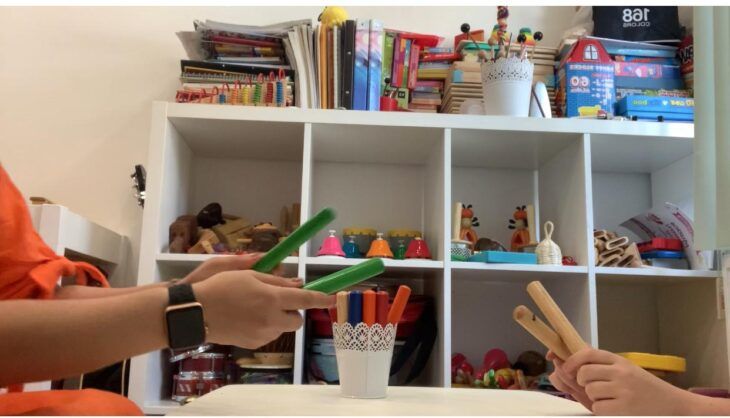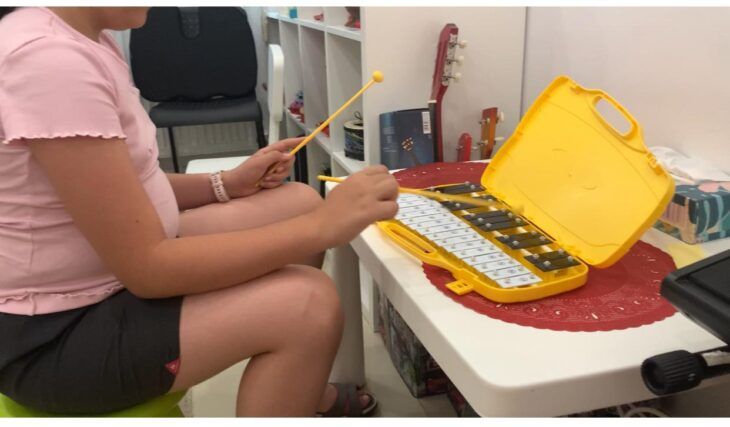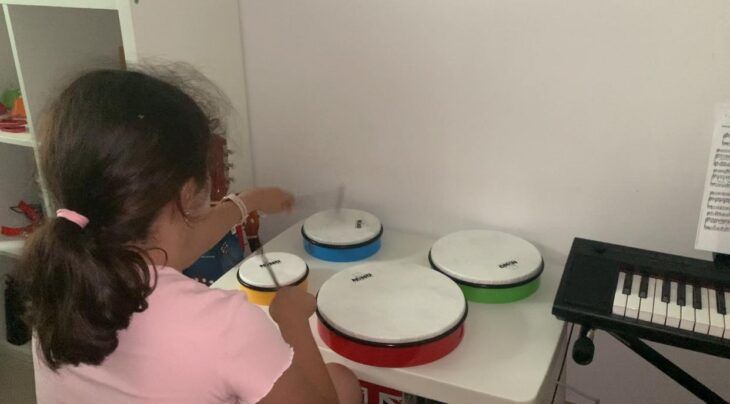Supporting another Romanian Partner with new musical instruments
Romania
- Children
- Disability

(Citiți această postare în Română.)
Florentina graduated from our Distance Learning Programme a few years ago and to support her continued work with music, she has received new instruments.
That’s right, I graduated from the course in 2017. After graduation, I got the courage and opened a Melotherapy Practice in Constanta and since then and until now I have been visited by many beneficiaries of all ages. The Intensive Study Weekend with Alexia Quin and Monica Manases (Szabo) greatly enriched my palette of musical exercises and activities and since then, I put into practice all the exercises I experienced that weekend. I also enjoyed the manual provided at the class and keep coming back to it to find the most appropriate activities for my young and old beneficiaries.
My practice is equipped with a variety of instruments acquired over time. As at this time most of my beneficiaries are children, many of them diagnosed with autism, many of the instruments have depreciated and no longer sound good, some have broken, others no longer work. So, I thought it would be appropriate to apply to the Music as Therapy International Instrument Fund, thinking that a new set of instruments could bring a new breath of fresh air to the old set of instruments, and thus, all together, stimulate everyone’s creativity, make their music sessions more interesting and enjoyable.
For me, every instrument in the cabinet is a joy of the heart. They are like my children that I have to take care of, but at the same time they are the magical instruments that help and support me in my daily work with my music partners. Each one individually and all together is a challenge for new activities, be it individual or group.

For me, each instrument comes alive in the hands of the recipients of life, each gets to tell a story and all together are part of a larger mission to bring joy to another heart, be it a child, an adult or an elder. The instruments, in the hands of those who cross my threshold, take on new meanings, and sometimes, an unsuspected force makes a sound produced to bring a comfort, a smile, a tear, sometimes it brings the utterance of a vowel or a word, sometimes it can bring out silence, anger, frustration. But each time, music opens the heart, and from there, it’s just one step closer to achieving the goals I set for myself in my music sessions.
I firmly believe that they will prompt me to come up with new ideas and activities that will also stimulate them in all areas of development, in all aspects.
My beneficiaries are of all sizes, at the moment around 40 beneficiaries – children and adults. I work with them individually or in groups. Each instrument is beneficial by its very nature. For example, for children who need support with their rhythm, I could use the new drums from Nino Percussion, finger cymbals or Claves also from Nino. We can also use the bamboo rainstick or clapper/Kokoriko to improvise, we can use the Glockenspiel combined with a drumstick, and with the cymbals use our voices to sing a ‘sunrise’ song, or about ‘thunder’ and ‘lightning storm’, for example. For those who need to learn colours or numbers we will use coloured bells or cat drums, and for those who need speech support we will sing vocals to certain sounds using the piano or xylophone, or by keeping a rhythm on the drums we say or try pronunciations or make sounds.

I also feel that for my older recipients, the new set of instruments will add value to the group sessions, where drums will certainly be in demand, setting the pace as we play a piece of a member’s heart. And the list can be diversified, especially from the ideas of each beneficiary. I like to let them choose their favourite activity and instruments to practice in order to stimulate their creativity and teach them to feel free.
I have long wanted to do an activity with a rhythmic melody as a background sound for a children’s group session. In the music room there are many tables and chairs in the shape of a circle – with a small space to enter the circle – on which a different instrument is placed. The children take turns to enter and sing in the canon, moving from one instrument to another, rhythmically matching the rhythm of the melody, and so the children change instruments in order, starting from one instrument to the second, to the third and so on, and they all end up singing as in an orchestra, louder and louder, and the intensity and rhythm decreases as the children finish the circle of instruments and leave the circle one by one. Then we discuss rhythm, loudness, intensity, how they felt and what emotions they felt while playing. I would then do the same exercise with a group of adults or older people and make a comparison based on their responses.
Thank you once again for this wonderful gift that only increases the quality of my work and, therefore, the results of my beneficiaries.
Florentina Gheorghe
